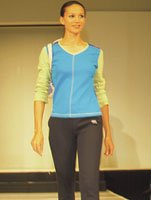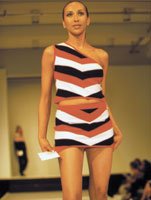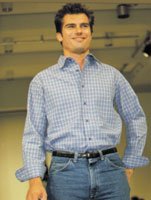Southern African Group Courts Local Manufacturers During L.A. Market
The small African island nation of Mauritius, the textile hub of Southern Africa, led a group of manufacturers in a two-part trade fair held May 31–June 2 on the market mezzanine at the California Mart.
The show was organized by SAATEX (the Southern Africa Apparel and Textile Exhibition) to increase import opportunities to the United States following the passing of the African Growth and Opportunity Act (AGOA) last year. The AGOA, which is part of the Caribbean Basin Initiative (CBI), provides quota-free and duty-free access into the U.S. market for apparel cut and assembled in Sub-Saharan Africa from U.S. fabrics, or from fabrics that are not available in commercial quantities in the U.S.
“Mauritius and Kenya were the only countries in Sub-Saharan Africa in which there was a quota,” said Elizabeth Ah Chong, deputy director of the Mauritius Industrial Development Authority (MIDA).
“The removal of the quota opens up the doors for us in this vast market,” she said.
Companies such as the Gap, Eddie Bauer and the Limited currently produce in Mauritius. Once SAATEX was formed by MIDA, plans were made to hit both shores of the U.S. The group moved on to New York where they held a similar show at the Hotel Pennsylvania.
“Although New York is a major center for all the big retailers [and] importers, we have been made to understand that the West Coast is also important,” Ah Chong said.
The primary goal in coming to Los Angeles is to make potential buyers aware of the supply capabilities among the Sub-Saharan nations, where labor is abundant and where potential for expansion in the apparel industry is broad. Some of the SAATEX participants work was on display at the Pacific Coast Travelers (PCT) fashion show on June 1 in the California Mart fashion theater.
Several SAATEXoslash; exhibitors confirmed that the buyers who stopped in their showrooms during the fair were interested in finding out more about producing in Sub-Saharan Africa rather than placing actual business. For the majority of the exhibitors, the SAATEX show was an awareness campaign.
Geraldine Lim-Sing Fat of Shibani Knitting Company reported that the show had good traffic and that she already knew what the purpose of exhibiting was.
“The show is good, she said. “Some of them will come to Mauritius, which is good. Our main objective is to make contacts, not necessarily take orders, so I’m happy.”
La Ronda Flowers of My Child’s Closet in Los Angeles confirmed that her intention was to come out and see what was available from the region as opposed to actually placing orders.
Small Nation, Big Plans
Mauritius is a very small nation, spanning just over 1,000 kilometers and with a population just over one million, but it is the largest exporter to the U.S. in Sub-Saharan Africa, Ah Chong explained. The majority of Mauritius’s apparel exports—70 percent—is currently to Europe, but the country plans to diversify and increase export to the U.S.
Annually, Mauritius exports 75 million T-shirts, 35 million trousers, including jeans, 16 million shirts and 15 million sweaters, as well as other apparel items. The greater percentage—65 percent—of its apparel exports is menswear.
There are 250 companies that make apparel in Mauritius. Thirty-three are in textiles—from spinning to weaving, knitting and dyeing. Approximately 60 percent of the production is made from local materials, 20 percent is made from fabrics from other Southern African nations and 20 percent is made from European fabrics.
Madagascar, Mozambique and South Africa have cotton production, but Mauritius still imports the majority of its cotton from outside of the region. The goal of Mauritius is to increase the weaving capacity of Southern African nations, while inviting other countries to set up local spinning mills.
“Mauritius imports 40,000 tons of cotton yarn from countries like Pakistan, India and China,” said Ah Chong. “Our aim is to be able to satisfy the requirements of the AGOA, which is to have more cotton spinning in Mauritius, and also to be able to source our yarn from the region itself.”
Ah Chong emphasized that including other Southern African nations in the creation of SAATEX was important because Mauritius will depend heavily on other Sub-Saharan African countries to help meet the production demands of U.S. production. Some Mauritius manufacturers have already opened production facilities in neighboring countries including Madagascar, Mozambique and Kenya, Ah Chong said.
U.S. Opportunities Abroad
Mauritius is also looking for overseas companies to set up facilities in the region, according to Ah Chong, who noted that firms from China and India have already expressed interest in opening spinning mills in the country.
“We expect one Chinese mill to be operational by next year,” she said, adding, “there is room for U.S. companies to set up mills in Mauritius, and we would like to invite the big companies here to set up their buying offices in Mauritius.”
Mauritius has a plan called the “Regional Headquarters Scheme,” which provides incentives to outside companies who wish to conduct their business within that country’s borders. Ah Chong emphasized that Mauritius is fully prepared for U.S. companies to establish local headquarters in the African Island nation.
“They can source from the region,” she said. “In terms of logistics for this part of the world, I believe that Mauritius is well developed to be able to respond to the requirements of the buyers in terms of delivery, communications.”
























